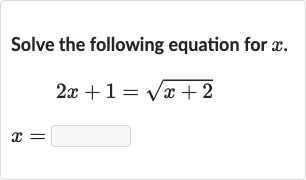AI tutor
Full solution
Q. Solve the following equation for .
- Square both sides: Square both sides of the equation to eliminate the square root.
- Expand using FOIL method: Expand the left side of the equation using the FOIL method (First, Outer, Inner, Last).
- Combine like terms: Combine like terms on the left side of the equation.
- Subtract from both sides: Subtract from both sides of the equation to bring all terms to one side.
- Subtract from both sides: Subtract from both sides of the equation to set the equation to zero.
- Quadratic equation: Now we have a quadratic equation. We can either factor it, complete the square, or use the quadratic formula to solve for . The quadratic formula is . For this equation, , , and .
- Calculate discriminant: Calculate the discriminant to determine if there are real solutions.Discriminant = Discriminant = Discriminant = Discriminant =
- Use quadratic formula: Since the discriminant is positive, there are two real solutions. Use the quadratic formula to find the values of .
- Calculate possible values for x: Calculate the two possible values for x. or or or
- Check solutions in original equation: We need to check both solutions in the original equation to ensure they do not result in taking the square root of a negative number.Check : (True)Check : (False)

